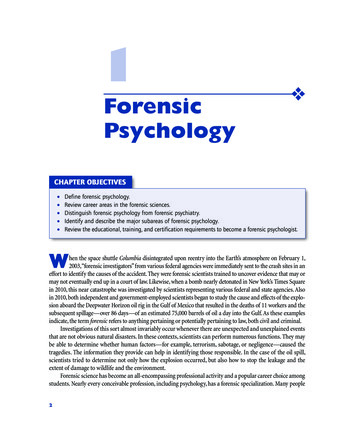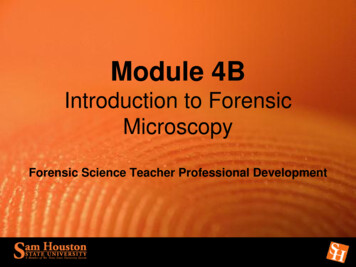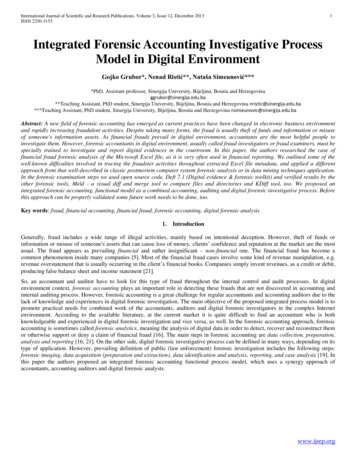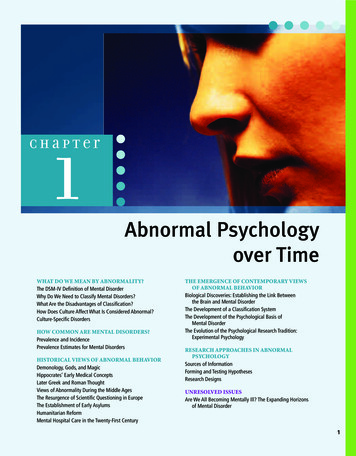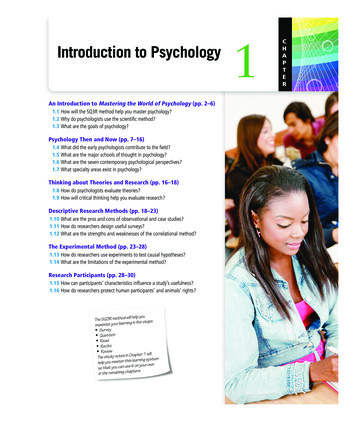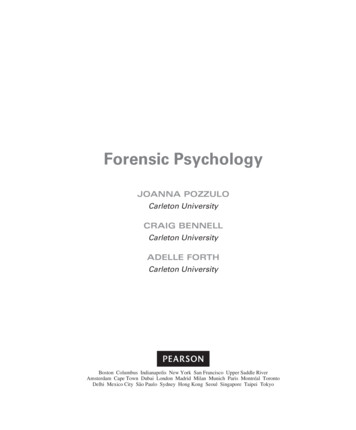
Transcription
Forensic PsychologyJOANNA POZZULOCarleton UniversityCRAIG BENNELLCarleton UniversityADELLE FORTHCarleton UniversityBoston Columbus Indianapolis New York San Francisco Upper Saddle RiverAmsterdam Cape Town Dubai London Madrid Milan Munich Paris Montréal TorontoDelhi Mexico City São Paulo Sydney Hong Kong Seoul Singapore Taipei TokyoA01 POZZ9279 01 SE FM.indd 105/10/12 7:46 PM
Editorial Director: Craig CampanellaEditor in Chief: Jessica MosherExecutive Editor: Susan HartmanEditorial Assistant: Shivangi RamachandranDirector of Marketing: Brandy DawsonMarketing Manager: Wendy AlbertMarketing Assistant: Frank AlarconDirector of Production: Lisa IarkowskiManaging Editor: Denise ForlowProduction Project Manager: Annemarie FranklinSenior Manufacturing and Operations Managerfor Arts & Sciences: Mary FischerOperations Specialist: Diane PeiranoArt Director, Cover: Jayne ConteCover Designer: Bruce KenselaarCover Art: ShutterstockSenior Digital Media Editor: Peter SabatiniDigital Media Project Manager: Pam WeldinFull-Service Project Management: MuralidharanKrishnamurthyComposition: S4Carlisle Publishing ServicesPrinter/Binder: Courier/WestfordCover Printer: Lehigh-Phoenix Color/HagerstownText Font: 10/12 Times LT StdCredits and acknowledgments borrowed from other sources and reproduced, with permission, in this textbook appear on the appropriatepage within text [or on page 418].Copyright 2013 Pearson Education, Inc. All rights reserved. Manufactured in the United States of America. This publication isprotected by Copyright, and permission should be obtained from the publisher prior to any prohibited reproduction, storage in aretrieval system, or transmission in any form or by any means, electronic, mechanical, photocopying, recording, or likewise. To obtainpermission(s) to use material from this work, please submit a written request to Pearson Education, Inc., Permissions Department, OneLake Street, Upper Saddle River, New Jersey 07458, or you may fax your request to 201-236-3290.Many of the designations by manufacturers and sellers to distinguish their products are claimed as trademarks. Where those designationsappear in this book, and the publisher was aware of a trademark claim, the designations have been printed in initial caps or all caps.Library of Congress Cataloging-in-Publication DataPozzulo, Joanna.Forensic psychology/Joanna Pozzulo, Craig Bennell, Adelle Forth.—1st ed.p. cm.ISBN 978-0-205-20927-9—ISBN 0-205-20927-01. Forensic psychology. I. Bennell, Craig. II. Forth, Adelle E. III. Title.RA1148.P69 20136149.15—dc23201202900110 9 8 7 6 5 4 3 2 1ISBN 10: 0-205-20927-0ISBN 13: 978-0-205-20927-9A01 POZZ9279 01 SE FM.indd 205/10/12 7:46 PM
This book is dedicated to our many studentswho challenge our thinking and inspire us.A01 POZZ9279 01 SE FM.indd 305/10/12 7:46 PM
Brief ContentsChapter 1An Introduction to Forensic Psychology 1Chapter 2Police PsychologyChapter 3The Psychology of Police Investigations 52Chapter 4DeceptionChapter 5Eyewitness TestimonyChapter 6Child Victims and WitnessesChapter 7Juries: Fact FindersChapter 8The Role of Mental Illness in Court 189Chapter 9Sentencing in the United States: Practices and Public Opinions 2092580Chapter 10 Risk AssessmentChapter 11 Psychopathy109137164233262Chapter 12 Assessment and Treatment of Juvenile Delinquency 283Chapter 13 Intimate Partner Violence 304Chapter 14 Sexual and Homicidal Offenders 328ivA01 POZZ9279 01 SE FM.indd 405/10/12 7:46 PM
ContentsPrefacexvAcknowledgmentsxviiAbout the AuthorsxviiiChapter 1 An Introduction to Forensic Psychology 1What Is Forensic Psychology? 2 In the Media The Reality of Reality TV3The Roles of a Forensic Psychologist 4 Box 1.1 Researcher Profile: Dr. Curt Bartol 5The Forensic Psychologist as Clinician 6The Forensic Psychologist as Researcher 7 Box 1.2 Other Forensic Disciplines8The Forensic Psychologist as Legal Scholar 8The Relationship Between Psychology and Law 9Psychology and the Law 9Psychology in the Law 9Psychology of the Law 10The History of Forensic Psychology 10Early Research: Eyewitness Testimony and Suggestibility 10Early Court Cases in Europe 12Advocates of Forensic Psychology in North America 13Forensic Psychology in Other Areas of the Criminal Justice System 14 Box 1.3 Biological, Sociological, and Psychological Theories of Crime 14Landmark Court Cases in the United States 16Signs of a Legitimate Field of Psychology 17Modern-Day Debates: Psychological Experts in Court 17 Box 1.4 Influential U.S. Court Cases in the History of Forensic Psychology18The Functions of the Expert Witness 19The Challenges of Providing Expert Testimony 19Criteria for Accepting Expert Testimony 20 CASE STUDY: You Be the Judge 22 Box 1.5 Daubert in Action: New Jersey vs. Fortin (1999–2000)22Chapter 2 Police Psychology 25Police Selection 26 In the Media Using Social Media to Recruit Police Officers 27A Brief History of Police Selection 27vA01 POZZ9279 01 SE FM.indd 505/10/12 7:46 PM
viContentsThe Police Selection Process 28 Box 2.1 Validation and Police Selection29The Validity of Police Selection Instruments 31Police Discretion 35Why Is Police Discretion Necessary? 36Areas Where Police Discretion Is Used 36 Box 2.2 Inappropriate Police Discretion: The Case of Racial Profiling 37 Box 2.3 Researcher Profile: Dr. Linda Teplin 39 CASE STUDY: You Be the Police Officer 40 Box 2.4 Police Brutality in the Rodney King Incident 41Controlling Police Discretion 42 Box 2.5 Use-of-Force Continuums43Police Stress 44Sources of Police Stress 45Consequences of Police Stress 46 Box 2.6 The Buffalo Cardio-Metabolic Occupational Police Stress (BCOPS) Study 47Preventing and Managing Police Stress 49Chapter 3 The Psychology of Police Investigations 52Police Interrogations 53The Reid Model of Interrogation 54The Use of the Reid Model in Actual Interrogations 56Potential Problems with the Reid Model of Interrogation 56 Box 3.1 Researcher Profile: Dr. Saul Kassin57Interrogation Practices and the Courts 59An Alternative to the Reid Model 60False Confessions 60The Frequency of False Confessions 61Different Types of False Confessions 61Studying False Confessions in the Lab 63 Box 3.2 The Curious Case of Paul Ingram63The Consequences of Falsely Confessing 65 CASE STUDY: You Be the Police Officer 66Criminal Profiling 67What Is a Criminal Profile? 67The Origins of Criminal Profiling 67 In the Media Hollywood Depictions of Criminal Profiling 68How Is a Criminal Profile Constructed? 70Different Types of Profiling Methods 70The Validity of Criminal Profiling 72Geographic Profiling 76A01 POZZ9279 01 SE FM.indd 605/10/12 7:46 PM
ContentsChapter 4 Deceptionvii80The Polygraph Technique 81Applications of the Polygraph Test 81Types of Polygraph Tests 82Validity of Polygraph Techniques 84Can the Guilty Learn to Beat the Polygraph? 86 Box 4.1 Seeing Through the Face of Deception87Scientific Opinion: What Do the Experts Say? 87Admissibility of Polygraph Evidence 88Brain-Based Deception Research 88Verbal and Nonverbal Behavior Cues to Lying 89 Box 4.2 Brain Fingerprinting: Evidence for a New Deception-Detection Technology?90Verbal Cues to Lying 92Are Some People Better at Detecting Deception? 92 Box 4.3 Quest for Love: Truth and Deception in Online Dating 93 In the Media TV and Lie Detection 94 Box 4.4 Detecting High-Stakes Lies 96Assessment of Malingering and Deception 97Disorders of Deception 97Explanatory Models of Malingering 98How to Study Malingering 99 Box 4.5 Researcher Profile: Dr. Richard Rogers 100 Box 4.6 Ethics of Deception Research 102Malingered Psychosis 102 Box 4.7 Being Sane in Insane Places 103 CASE STUDY: You Be the Forensic Psychologist105Assessment Methods to Detect Malingered Psychosis 106Chapter 5 Eyewitness Testimony 109Eyewitness Testimony: The Role of Memory 110How Do we Study Eyewitness Issues? 111The Laboratory Simulation 111Recall Memory 113Interviewing Eyewitnesses 113The Leading Question—The Misinformation Effect 114 Box 5.1 Researcher Profile: Dr. Elizabeth Loftus 115Procedures That Help Police Interview Eyewitnesses 116Hypnosis 116The Cognitive Interview 117 Box 5.2 How the Cognitive Interview Components Are Implemented with Witnesses 118A01 POZZ9279 01 SE FM.indd 705/10/12 7:46 PM
viiiContentsRecall of the Culprit 119Quantity and Accuracy of Descriptions 119Recognition Memory 120Lineup Identification 120Voice Identification 125Are Several Identifications Better Than One? 125Are Confident Witnesses Accurate? 126Estimator Variable Research in Recognition Memory 127Expert Testimony on Eyewitness Issues 130Public Policy Issues and Guidelines 130 CASE STUDY: You Be the Judge 131 Box 5.3 A Case of Wrongful Conviction 132 In the Media Eyewitness Identification Bill 117 133 Box 5.4 DNA Exoneration Fact Sheet 134Chapter 6 Child Victims and Witnesses 137History 138 Box 6.1 Preschools on Trial139Recall for Events 140Free Recall versus Directed Questioning 140 CASE STUDY: You Be the Forensic Psychologist Box 6.2 Researcher Profile: Dr. Stephen Ceci 142141Why Are Children More Suggestible Than Adults? 143Other Techniques for Interviewing Children 143Recall Memory Following a Long Delay 149Can Traumatic Memories Be Forgotten? 150 Box 6.3 Delayed Memory Goes to Court 150 Box 6.4 Delayed Prosecutions of Historic Child Sexual Abuse 151Recall for People 152Describing the Culprit 152Recognition 154Lineup Procedure and Identification Rates 154Testifying in Court 155Courtroom Accommodations 156Child Maltreatment 157 Box 6.5 A Case of Neglect or Forgetfulness?158Risk Factors Associated with Child Maltreatment 159Short-Term and Long-Term Effects of Physical Abuse 159Short-Term and Long-Term Effects of Sexual Abuse 160A01 POZZ9279 01 SE FM.indd 805/10/12 7:46 PM
Contentsix Box 6.6 Luring Children over the Internet 162 In the Media To Catch a Predator 162Chapter 7 Juries: Fact Finders 164Getting to Trial 165Grand Jury 165Petit Jury 165Jury Selection 166Predicting Who Will Be a Favorable Juror—Pro-Prosecution versus Pro-Defense 167Scientific Jury Selection 167Methodology Used for Scientific Jury Selection 168Characteristics and Responsibilities of Juries 168Representativeness 169 Box 7.1 Balancing a Jury by Race169Impartiality 170 Box 7.2 Change of Venue Granted 171 Box 7.3 Probing Jurors’ Religious Biases172Jury Functions 172How Do we Study Jury Behavior? 173Post-Trial Interviews 173Archives 174Simulation 174Field Studies 174Reaching a Verdict 175Listening to the Evidence 175Disregarding Inadmissible Evidence 176 In the Media The CSI Effect177Judge’s Instructions 178Jury Decision-Making Models 178Deliberations 180The Final Verdict 180Predicting Verdicts 181Demographic Variables 181Personality Traits 182Attitudes 182Defendant Characteristics 183Victim Characteristics 184A01 POZZ9279 01 SE FM.indd 905/10/12 7:46 PM
xContents Box 7.4 Researcher Profile: Dr. Bette Bottoms 185Expert Testimony 186 CASE STUDY: You Be the JurorChapter 8 The Role of Mental Illness in Court187189Diagnosing Mental Disorders 190Presumptions in the Criminal Justice System 191Competency to Stand Trial 191Raising the Issue of Competency 191How Many Defendants Are Referred forCompetency Evaluations? 192Who Can Assess Competency? 192Competency Instruments 192Distinguishing between Competent and Incompetent Defendants 193 Box 8.1 Competency Instruments 193 CASE STUDY: You Be the Judge 195How Is Competency Restored? 196 Box 8.2 Mentally Ill But Competent to Make Treatment Decisions? 196What Happens after a Finding of Incompetency? 197Mental State at Time of Offense 197Mental Illness and Verdict 199 Box 8.3 Multimillionaire John du Pont: A Mentally Ill Killer 200Using the Insanity Defense 200 Box 8.4 Researcher Profile: Dr. Henry (Hank) Steadman 201Assessing Insanity 202What Happens to a Defendant Found “Insane”? 202Defendants with Mental Disorders 203Why Are There Such High Rates of Mental Illnessin Offender Populations? 203Dealing with Offenders Who Are Mentally Ill 203Bias against Offenders Who Are Mentally Ill 204Are People with Mental Illnesses Violent? 204Treatment of Offenders with Mental Disorders 205 In the Media Are Offenders with Mental Illness Really Violent? 205A New Court for People with Mental Illness: The Mental Health Courts 206Are Mental Health Courts Effective? 207A01 POZZ9279 01 SE FM.indd 1005/10/12 7:46 PM
xiContentsChapter 9 Sentencing in the United States: Practices and Public Opinions209The Structure of the U.S. Court System 210Sentencing in the United States 212The Purposes of Sentencing 212The Principles of Sentencing 213Sentencing Options in the United States 214 Box 9.1 Creative Sentencing in the United States 215Factors That Affect Sentencing Decisions 216 Box 9.2 Do Male Offenders Get the Short End of the Stick When It Comes to Sentencing? CASE STUDY: You Be the Judge 218217Sentencing Disparity 218 In the Media Twitter Goes to Court: The Role of Social Media in the Casey Anthony Case220Are the Goals of Sentencing Achieved? 223 Box 9.3 Researcher Profile: Dr. Francis Cullen 224What Works in Offender Treatment? 226 Box 9.4 The Ineffectiveness of Scaring Kids Straight 227Public Attitudes Toward Sentencing 228The Media’s Influence on Public Opinion 230Chapter 10 Risk Assessment 233What Is Risk Assessment? 234Risk Assessments: When Are They Conducted? 234Civil Setting 235Criminal Settings 236Types of Prediction Outcomes 237The Base Rate Problem 237A History of Risk Assessment 238 Box 10.1 Researcher Profile: Dr. John Monahan 240Methodological Issues 240Judgment Error and Biases 241Approaches to the Assessment of Risk 242 Box 10.2 Dr. Death: A Legendary (Notorious) Forensic Psychiatrist243Types of Risk Factors 244Important Risk Factors 245Dispositional Factors 245Historical Factors 246Clinical Factors 247Contextual Factors 248 In the Media Megan’s Law: Attempting to Prevent CrimeA01 POZZ9279 01 SE FM.indd 1124905/10/12 7:46 PM
xiiContentsRisk Assessment Instruments 250 Box 10.3 Risk Assessment Instruments251Current Issues 254Where Is the Theory? 254What about Female Offenders? 254 Box 10.4 Coping-Relapse Model of Criminal Recidivism 255 CASE STUDY: You Be the Parole Board Member 256What about Protective Factors? 257Risk Assessment: Risky Business? 258Are Decision Makers Using the Scientific Research? 258Why Do Some Individuals Stop Committing Crimes? 259 Box 10.5 Why Do High-Risk Violent Offenders Stop Offending? 260Chapter 11 Psychopathy 262Assessment of Psychopathy 263 Box 11.1 Subclinical Psychopaths: University Samples265Psychopathy and Antisocial Personality Disorder 265What Makes Them Tick?: Cognitive and Affective Models of Psychopathy 266 Box 11.2 Researcher Profile: Dr. Joseph Newman268Psychopathy and Violence 269 Box 11.3 A Psychopath among Us: Serial Killer Ted Bundy270Psychopaths in the Community 272 In the Media Mean on the Screen: Media’s Portrayal of Psychopaths 273Psychopathy and Sexual Violence 273Psychopathy in Youth 274 Box 11.4 Psychopathy Label: The Potential for Stigma 275Psychopathy: Nature vs. Nurture? 277Does Family Matter? 277Psychopathy and Treatment 278Forensic Use of Psychopathy 279Psychopathy and Law Enforcement 279 CASE STUDY: You Be the Researcher281Chapter 12 Assessment and Treatment of Juvenile Delinquency 283Young Offenders 284Historical Overview 284Modern Day 284 Box 12.1 The Death Penalty for Juveniles? 285 Box 12.2 The Dartmouth Murders 286 CASE STUDY: You Be the Police Officer 287A01 POZZ9279 01 SE FM.indd 1205/10/12 7:46 PM
ContentsxiiiYouth Crime Rates 287Assessment of Young Offenders 288Assessing Those under Age 12 288Assessing the Adolescent 290 Box 12.3 Researcher Profile: Dr. Rolf Loeber 290Rates of Behavior Disorders in Youth 291Trajectories of Young Offenders 291 Box 12.4 Teen Killers292Theories to Explain Antisocial Behavior 293Biological Theories 293Cognitive Theories 293Social Theories 294Risk Factors 294Individual Risk Factors 294 In the Media Do Video Games Desensitize Teens?295Familial Risk Factors 295School and Social Risk Factors 296Protective Factors 296 Box 12.5 Running Around with the Wrong Crowd: Gangs297Individual Protective Factors 298Familial Factors 298Social/External Protective Factors 298Prevention, Intervention, and Treatment of Young Offending 298Primary Intervention Strategies 298Secondary Intervention Strategies 300Tertiary Intervention Strategies 301Chapter 13 Intimate Partner Violence304Types of Violence and Measurement 306 Box 13.1 Researcher Profile: Dr. Murray Straus 306Intimate Partners: A Risky Relationship 308 Box 13.2 Husband Battering Does Exist309Theories of Intimate Partner Violence 310Why Do Battered Women Stay? 312 Box 13.3 Myths and Realities Concerning Intimate Partner Violence 312A Heterogeneous Population: Typologies of Male Batterers 315 Box 13.4 Woman’s Best Friend: Pet Abuse and Intimate Violence315Criminal Justice Response 316 Box 13.5 Tracey Thurman: Calls for Help Ignored 317A01 POZZ9279 01 SE FM.indd 1305/10/12 7:46 PM
xivContentsEffectiveness of Treatment of Male Batterers 319 CASE STUDY: You Be the Judge321Stalking: Definition, Prevalence, and Typologies 322 In the Media Dangerous Fixations: Celebrity Stalkers 325Chapter 14 Sexual and Homicidal Offenders 328Sexual Offenders 329Nature and Extent of Sexual Violence 329Definition of Sexual Violence 330Consequences for Victims of Sexual Violence 330Classification of Sexual Offenders 331 Box 14.1 Sexual Assault: Discounting Rape Myths 332 Box 14.2 Is Resisting a Sexual Attack a Good Idea? 333 Box 14.3 Researcher Profile: Dr. Raymond Knight 334Adolescent Sexual Offenders 336Female Sexual Offenders 337Theories of Sexual Aggression 338Assessment and Treatment of Sexual Offenders 339 CASE STUDY: You Be the Forensic Psychologist341Effectiveness of Treatment for Sexual Offenders 343 Box 14.4 Relapse Prevention with Sexual Offenders 343Homicidal Offenders 345Nature and Extent of Homicidal Violence 346Bimodal Classification of Homicide 347Filicide: When Parents Kill 347Mothers Who Kill 348Fathers Who Kill 349 Box 14.5 From Devotion to Depression: A Mother Who Killed 349Youth Who Kill 350Spousal Killers 350Serial Murderers: The Ultimate Predator 351Mass Murderers 354Theories of Homicidal Aggression 355 In the Media The Mass Media and Antisocial Behavior 355Treatment of Homicidal Offenders 357Glossary360References 368Credits418Case Index 423Name IndexSubject Index424436A01 POZZ9279 01 SE FM.indd 1405/10/12 7:46 PM
PrefaceThis is an exciting time in the field of forensic psychology, with many new developments by theorists andresearchers. For example, new insights into the biological underpinnings of antisocial behavior, innovativemethods for interviewing child witnesses, theories of women offending, and novel methods of assessing violence risk have been developed. Forensic Psychology is designed primarily for use in undergraduate courses,although graduate students and practitioners may find the comprehensive and up-to-date summary of key areasa useful resource.We have taken a broad-based perspective that incorporates both experimental and clinical topics. The textcovers topics that might otherwise be discussed in traditional social and cognitive psychology courses—includingeyewitness testimony, jury decision making, and police procedures—as well as topics that are clinical in natureand might otherwise be discussed in traditional personality or abnormal psychology courses—such as the meaning of competency to stand trial, mentally disordered offenders, sex offenders, and psychopathy. Our goal is topresent the important ideas, issues, and research in a way that students will understand and enjoy, and in somecases find them useful in their professional careers. To provide students with a glimpse into the life of an academic,each chapter includes a profile of a prominent U.S. researcher. We hope that the academic community will findthis textbook a valuable teaching tool that provides a comprehensive and current coverage of forensic psychology.Distinguishing FeaturesThe pedagogical aids are designed to promote student learning and assist instructors in presenting key material.Important features include the following: Learning Objectives and End-of-Chapter Summaries. Each chapter starts with a list of learning objectives to guide students’ learning of the material and closes with a summary linked to the learningobjectives. Vignettes. Chapter-opening vignettes provide students with a context for the key concepts they willencounter in each chapter. These engaging vignettes present real-world scenarios in which students, orpeople they know, could potentially find themselves. Boxes. Boxed features within the chapters provide interesting asides to the main text. Some detail currentAmerican cases and legal rulings, while others highlight “hot” topics in the news that have not yet beenthe subject of much psychological research. These boxes will develop students’ consciousness of currentissues and hopefully spark some research ideas. Case Studies. With the case studies, students are encouraged to take an active role—putting themselvesin the shoes of judges, forensic psychologists, police officers, and so on—in applying material from thechapter to a related scenario. In the Media. These boxes highlight current issues being portrayed in the media that relate to thechapter topics. Profiles of U.S. Researchers. To expose students to the varied and excellent research in forensic psychology being conducted by Americans, each chapter includes a profile of a key American researcherwhose work is relevant to the chapter topic. These profiles highlight educational background, currentposition, and research interests, along with a little about the researcher’s personal life, so students realizethey are people too. Research Methodology. Research methodology specific to forensic topics is described in the relevantchapters, with the goal of helping students understand how studies in forensic psychology are conducted.xvA01 POZZ9279 01 SE FM.indd 1505/10/12 7:46 PM
xviPreface Research Studies. Data reported in original studies is cited throughout the textbook, often in graph ortable form for easy interpretation. Diagrams of psychological models and flow charts demonstrate keyprocesses that occur through the criminal justice system. Theoretical Perspectives. Theories relevant to specific topics areas are described in each of the relevantchapters. The discussion of the various theories emphasizes a multidisciplinary approach, showing theinterplay among cognitive, biological, and social factors in understanding the different forensic psychology areas. Law. Forensic Psychology provides the student with information on current U.S. law relevant to the psychological issues discussed. Discussion Questions. Several discussion questions are offered at the end of each chapter. Instructorscan assign these questions for group discussion, or students can use the questions to examine their comprehension and retention of the chapter material. We hope these questions will inspire critical thought instudents. Key Terms and Glossary. Throughout the chapters, key words with which students in forensicpsychology should be familiar with appear in bold type and are defined in marginal notes. These keyterms and their definitions are also provided in a glossary at the end of the book for easy reference.Supplements for InstructorsPearson is pleased to offer the following supplements to qualified instructors. Instructor’s Manual with Tests (0-205-94928-2): The instructor’s manual is a wonderful tool for classroom preparation and management. Corresponding to the chapters in the text, each of the manual’s chapters contains a brief overview of the chapter with suggestions on how to present the material, samplelecture outlines, classroom activities and discussion topics, ideas for in-class and out-of-class projects,and recommended outside readings. The test bank contains multiple-choice, short answer, and essayquestions, each referencing the relevant page in the text. MySearchLab (0-205-94993-2): MySearchLab with eText provides engaging experiences that personalize learning, and comes from a trusted partner with educational expertise and a deep commitment tohelping students and instructors achieve their goals. Survey Tool: Instructors can survey their students and generate real-time customized reports. eText: Just like the printed text, you can highlight and add notes to the eText or download it toyour iPad. Assessment: Chapter quizzes and flashcards offer immediate feedback and report directly to thegradebook. Writing and Research: A wide range of writing, grammar, and research tools and access to a varietyof academic journals and Census data help you hone your writing and research skills.A01 POZZ9279 01 SE FM.indd 1605/10/12 7:46 PM
AcknowledgmentsThis book would never have come to fruition had we not been mentored by outstanding forensic researchers.Joanna Pozzulo is indebted to Rod Lindsay at Queen’s University for his unfailing support, his rich insights, andhis commitment to academic excellence that she aspires to achieve. Craig Bennell is grateful to David Canter atthe University of Liverpool for providing a stimulating intellectual environment in which to study and for teaching him how to think critically. Adelle Forth wishes to express her admiration, respect, and gratitude to RobertHare at the University of British Columbia, who nurtured her interest in the area of psychopathy and who hasprovided consistent support and guidance. These researchers continue to be a source of inspiration to us.We would like to acknowledge that the forensic program at Carleton University, of which we are part,would not exist without our colleagues Shelley Brown, Kevin Nunes, and Ralph Serin who have contributed toour program and our thinking of forensic issues.We are thankful to the exceptional researchers we profiled in this textbook for giving us their time andinsight into their life. Specifically, Curt Bartol, Linda Teplin, Saul Kassin, Richard Rogers, Elizabeth Loftus,Stephen Ceci, Bette Bottoms, Hank Steadman, Francis Cullen, John Monahan, Joseph Newman, Rolf Loeber,Murray Strauss, and Raymond Knight. All have made significant contributions to the field of forensic psychology.We would like to thank the reviewers who provided us with exceptional feedback that allowed us tomake the textbook stronger. Reviewers include the following:Robert MorganTexas Tech UniversityMohammad Khalid HamzaLamar UniversityÉva SzeliArizona State UniversityKathleen HartXavier UniversityZeiven BeitchmanNova Southeastern UniversityJennifer BeaudryUniversity of South Carolina BeaufortAndy YoungLubbock Christian UniversityRussell EspinozaCalifornia State UniversityDan MurrieUniversity of VirginiaJessica LangleyUniversity of New HavenMichael VitaccoMedical College of GeorgiaWe have tried to incorporate as many of the suggestions as possible, but of course we were restricted interms of page length. In the end, we feel this textbook provides excellent breadth and good depth.We thank our many undergraduate and graduate students who over the years have challenged our thinkingand who have influenced the ideas expressed in this book. We also would like to thank the great staff at Pearson.Susan Hartman, Jessica Mosher, Shivangi Ramachandran, and Muralidharan Krishnamurthy at S4CarlislePublishing Services deserve special mention—this book would not exist without their enthusiasm, expertise, anddedication. Tara Tovell (copy editor), Amanda Wesson (production editor), and Sandy Cooke (photo researcher)also played important roles in making Forensic Psychology become a reality.Finally on a personal note, Joanna Pozzulo would like to thank her nieces, Jessica and Emma, for makingher feel like the coolest aunt ever. She also would like to thank Craig and Adelle for being great collaborators,dear friends, and putting up with her idiosyncrasies. Craig Bennell would like to thank his wife Cindy for herlove, patience, and support during the long hours of writing, and his sons Noah and Elijah for making himalways remember what is most important. Adelle Forth would like to thank her partner, colleague, and friend,John Logan, for his insights, suggestions, and feedback that improved the book, as well as his understandingand support while preparing the book. She would also like to acknowledge the contribution of her numerousfour-legged furry friends for keeping her sane.xviiA01 POZZ9279 01 SE FM.indd 1705/10/12 7:46 PM
About the AuthorsDr. Joanna Pozzulo is a Professor in the Department of Psychology at Carleton University in Canada.Dr. Pozzulo’s research and teaching falls under the domain of Forensic Psychology (borrowing from developmental, social, and cognitive psychology). Dr. Pozzulo is focused on understanding the development of facememory and the procedures that police can use to increase the reliability of face identification from lineups wthan emphasis on children’s identification evidence. Dr. Pozzulo also is a child clinical psychologist registeredwith the Ontario College of Psychologists.Dr. Craig Bennell is an Associate Professor in the Department of Psychology at Carleton University inCanada where he also serves as Director of the Police Research Lab. Research in Dr. Bennell’s lab is focusedon assessing the reliability and validity of procedures used within criminal investigations, such as offenderprofiling, and in understanding the factors that influence police decision making, particularly in use of forceencounters. Dr. Bennell is currently the co-editor of the Journal of Police and Criminal Psychology andthe incoming President of the Society for Police and Criminal Psychology. He teaches classes in forensicpsychology and police psychology.Dr. Adelle Forth is an Associate Professor in the Department of Psychology at Carleton University in Canadawhere she also serves as Directo
BrieF Contents Chapter 1 An Introduction to Forensic Psychology 1 Chapter 2 Police Psychology 25 Chapter 3 The Psychology of Police Investigations 52 Chapter 4 Deception 80 Chapter 5 Eyewitness Testimony 109 Chapter 6 Child Victims and Witnesses 137 Chapter 7 Juries: Fact Finders 164 Chap




